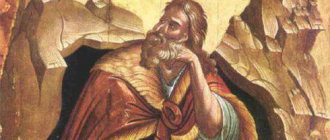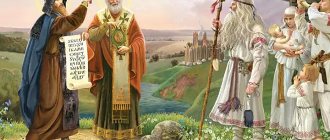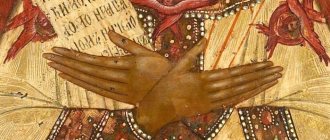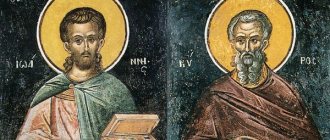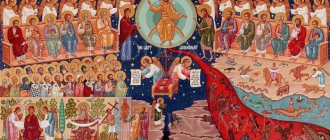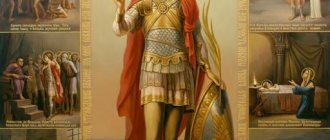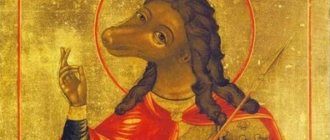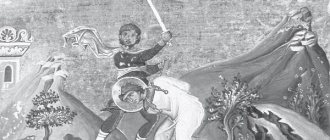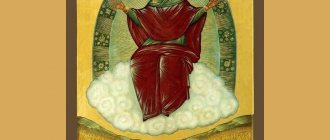The first Christians had to make countless sacrifices before they were no longer persecuted for their faith, and their religion was officially recognized in the Roman Empire. This happened in 313 by decree of Emperor Constantine the Great. Emperor Diocletian, who ruled before him, adhered to the pagan faith and was an ardent persecutor of all who professed Christianity.
Memorial Day: December 26
Many passion-bearers suffered torment for their faith during his reign and were subsequently canonized. One of them was the martyr Eugene of Sebaste, whose icon recalls his great feat of faith.
Holy Martyr Eugene prayer
We will try to answer the question in detail: holy martyr Eugene prayer on the website: prayer-to-god.rf - for our dear readers.
Holy passion-bearers of the quintuplet, warm prayer books for our souls, seeing our troubles and misfortunes, sorrows, needs and misadventures, help us, glorious sufferers, who honor you with faith and love. Amen.
Troparion to the holy martyrs Eustratius, Auxentius, Eugene, Mardarius and Orestes
The martyr of the all-honorable lordship, the five-numbered passion-bearers, let us sing the glory of those who despised the earth, the bright sun Eustratius, the wise spirit of the sufferers, who dared to face fire and torment for all the King Christ and from the Throne of That Glory bestowed with honors crowns. Through those prayers, O Christ God, save our souls.
Lamps of light appearing, Divine martyrs, illuminating all creation with the light of miracles, resolving ailments, and always driving away deep darkness, constantly praying to Christ God for all of us.
We magnify you, passion-bearers Saints Eustratius, Auxentius, Eugene, Mardarios and Orestes, and we honor your honest sufferings, which you naturally endured for Christ.
Popular prayers:
Prayers to Nicholas Archbishop Myra of Lycia
Prayers to Hieromartyr Blaise of Sebastia
Prayer to Saint Maruf, Bishop of Mesopotamia
Prayer to Saint Boniface the Merciful
Prayers to Saint Andrew, the Fool for Christ's sake
Prayer to St. John of Rila
Prayer to Saint Theodosius, Archbishop of Uglitsky and Chernigov
Prayer to the Holy Venerable John Kushchnik
Prayer to the Supreme Apostle Paul
Prayers to St. Onuphrius, Tsarevich of Persia
Prayer to the First Martyr Equal to the Apostles Thekla
Prayer to St. Gregory, icon painter of Pechora
Psalms 34, 90. Prayer to the honorable cross: May God rise again. Psalm to David
Prayers before the icons of the Blessed Virgin Mary
Orthodox informers for websites and blogs All prayers.
Icon of the Holy Martyr Eugene of Sebaste
Martyr Eugene of Sevastia
Translated from Greek, the name Eugene means “noble.”
The holy martyr Eugene suffered for his religion and refused to obey the Roman authorities, openly declaring his faith, for which he was executed.
Prayer before the icon of the Holy Martyr Eugene of Sebaste will help in all troubles and needs, in overcoming spiritual turmoil, in strengthening the spirit.
Pray to God for me, holy servant of God Eugene, as I diligently resort to you, a quick helper and prayer book for my soul.
Memorial Day: December 26
Martyr Eugene of Sebaste (icon in wooden frame)
With the saint, the martyr Eugene suffered cruelly for Christ under the emperor Diocletian (284-305) in Sebastia of Armenia.
Emperor Diocletian, wanting to revive the fading pagan religion, in the year 302 issued a decree that ordered the destruction of Christian churches and depriving Christians of all civil rights and positions. Soon after this, he issued a second decree ordering that all measures be used to persuade Christians to renounce their faith, and that those who disobey should be executed.
The hatred of the pagans for Christians was too great for these imperial decrees to remain inactive.
Soon, following the denunciation of enemies, the prisons were filled with Christian bishops, presbyters and laymen.
In Armenia, the presbyter of the Arabrakin Church, Auxentius, was captured, who, along with other Christians, was brought to trial in the city of Satalion by the regional ruler Lysias, a cruel persecutor of Christians.
In Satalion, Eustratius commanded the army. Christian, pious husband, preacher of the Christian way of life. Having learned that Presbyter Auxentius was in the city prison, Eustratius came to him and asked him to pray that the Lord would strengthen him for martyrdom.
And when the presbyter Auxentius, together with other imprisoned Christians, appeared for trial, Eustratius declared himself a Christian. The angry Lysias ordered to deprive Eustratius of all military ranks and subject him to torture. Eustratius’s friend, Eugene, also a military leader, wished to share the fate of his friend Eustratius and publicly declared himself a Christian.
He was immediately put in chains and thrown into prison with others.
In the morning, all prisoners were taken to the city of Nikopol. In chains, under blows, the soldiers drove away the holy martyrs, and they also put on Eustratia boots with nails that pierced his feet.
Following their path of suffering, the martyrs had to pass through their hometown of Arawrakin.
Citizens came out to see Eustratius, whom everyone loved and respected, but did not dare to approach him, because they were afraid to incur the wrath and persecution of their superiors.
However, a certain Mardarius neglected the danger. Leaving his family in the care of pious neighbors, and more so in the providence of God, he followed his friends, ready to accept the crown of martyrdom. To all the threats of Lysias, Mardarius meekly answered: “I am a Christian.” Presbyter Auxentius, Eugene and Mardarius were executed after many tortures.
Before his execution, Saint Mardarius prayed to the Lord: “Lord God the Father Almighty, Lord the Only Begotten Son Jesus Christ and the Holy Spirit, one Divinity and one Power, have mercy on me, a sinner, and in ways known to You, save me, Your unworthy servant, because You are blessed forever.
Amen” (This prayer of Saint Mardarius is read in the temple at the end of the 3rd hour).
New martyrs were brought in to replace the newly tortured Christians, ready to seal their fidelity and love for Christ with their blood. Governor Lysias, seeing the cross on the chest of his warrior Orestes, asked: “Aren’t you a Christian?” Orestes did not deny: “I am a servant of the Most High God,” he answered. He was immediately captured and added to the other martyrs.
When they came to Nikopol, many soldiers also declared themselves Christians. Lysias was confused; he was afraid that the execution of so many Christians would cause unrest among the people and sympathy for the martyrs. He decided to send Eustratius and Orestes to the city of Sebastia, where the city ruler was a certain Agricolaus, known for his cruelty.
Saint Eustratius, appearing before his new tormentor, spoke to him so wisely and convincingly about God, about His love, about the ineffable goodness that prompted the Son of God to become incarnate and suffer for people, about the madness and vanity of idolatry, that the cruel judge bowed to mercy. Wanting to save Eustratius, he convinced him to pretend to renounce Christ and make a sacrifice to the gods, promising him gifts and honors. But Evstratiy remained unshaken. Then, before his eyes, the young warrior Orestes was tortured on a hot bed. Now Evstratiy was left alone.
The holy martyr spent his last night in prison in unceasing prayer, strengthened by God for the coming suffering. The next morning Eustratius joyfully listened to his death sentence. With prayer on his lips, he entered the fiery furnace and in it he gave up his spirit to the Lord.
Seeing the torment of Saint Eustratius, his courage, patience and the miracle of our Lord Jesus Christ revealed to him, Saint Eugene exclaimed in a loud voice: “Fox! And I am a Christian and I curse your faith and refuse to obey, like my master Eustratius, the royal decree and you! The martyr Eugene had his tongue torn out, his arms and legs cut off, and his head cut off with a sword.
Subsequently, in memory of the five holy martyrs (Eugene, Auxentius, Eustratius, Mardarius and Orestes) a temple was built near Constantinople in the fence of the Olympus Monastery.
icons of patron saints
Icon painter Marina Filippova paints icons of patron saints , imbued with the personality of the person who wants to receive the icon, writes specifically for this person, feeling what palette, what sound of color, or rather, the light coming from the painted images, will be closer to the soul of the person praying, more healing for his spirit.
The icons of the patron saints of the venerable bear within themselves the prototypes of those who, with their entire earthly life, with all their might, sought to become like the spiritual heights to which the Lord calls us. The blessed ones, for example, also stand on the same level as the saints, only their earthly lives were different. They led the life of holy fools, but, like the saints, they had the gift of prophecy and wonderworking during their lifetime.
We call saints people who during their lifetime had a metropolitan rank - an episcopal rank, who through their lives as primates raised their flock in the Christian spirit. We see their faces on the icons of the patron saints of Nicholas of Myra. Spyridon of Trimifuntsky. Tikhon of Zadonsk, Philaret of Moscow, Theophan the Recluse.
Equal to the Apostles brought people the light of Christ's teaching, defended, like the Apostles, the Christian faith in all corners of the earth, that is, they led a life equal to the life of His disciples after His Ascension, defending the true faith and its values and expanding the borders of the Christian world, but not with the sword, but with words and example. Since ancient times, icons of patron saints depicting Equal-to-the-Apostles Constantine and Helen. Duchess Olga. the noble princes Alexander Nevsky and Dmitry Donskoy became images of house churches and home iconostases.
Those who have sick people in their family and who need frequent daily prayer for healing from an illness should choose icons of saints - patron saints of healers and miracle workers, for example Panteleimon. or the unmercenary doctors of the martyrs Cosmas and Damian. Cyrus and John.
Icons of patron saints. their amazing, bright faces accompany the spiritual and worldly life of every Orthodox Christian.
And when we need the highest help of the Lord himself, and it seems to us that our prayer is not complete or not strong, we turn to them for prayerful help and intercession and, standing in front of the icons of saints - patron saints of healers, martyrs, equal to the apostles and saints, we ask them to convey our prayers go all the way to His Throne.
Sources: //iconochka.com.ua/shop/evgeniy, //gitie.ru/Ikoni/Ikon41.html, //iconkuznetsov.ru/index.php?sid=358&did=189NULL No comments yet!
Source: //xn—-7sbebizuhsg3bs.xn--p1ai/svyatoj_muchenik_evgenij_molitva/
Monument
The memory of Evgeniy Rodionov, who died heroically in Chechnya, and in his homeland in the Penza region are immortalized. There, in the city of Kuznetsk, on September 25, 2010, the opening of the monument took place. The monument to the warrior Eugene looks like a bronze candle, the flame of which seems to embrace a soldier holding a cross in his hands. The author of the monument is the sculptor-artist Sergei Mardar.
The monument to the warrior Eugene is located on the territory of school No. 4, where Rodionov studied, and which is now named after him. At its opening, a solemn meeting took place, which brought together city residents of different ages. Guests of Kuznetsk also attended this event.
In the speeches of all the speakers there were words of gratitude to the hero’s mother, who was able to raise her son with dignity, and then herself accomplished a maternal feat.
The monument, called “Candle of Memory,” was unveiled:
- Head of the Department of Educational Work at the Border Service of the FSB of the Russian Federation V.T. Borzov; - Colonel of the Alpha group S.A. Polyakov; - Chairman of the Board of the regional veterans organization “Combat Brotherhood” Yu.V. Krasnov; - Chairman of the Council of Veterans of Local Armed Conflicts and Wars of the city of Kuznetsk P.V. Ildeikin.
Icon of the Holy Martyr Eugene: what it helps with
The first Christians had to make countless sacrifices before they were no longer persecuted for their faith, and their religion was officially recognized in the Roman Empire. This happened in 313 by decree of Emperor Constantine the Great. Emperor Diocletian, who ruled before him, adhered to the pagan faith and was an ardent persecutor of all who professed Christianity.
Memorial Day: December 26
Many passion-bearers suffered torment for their faith during his reign and were subsequently canonized. One of them was the martyr Eugene of Sebaste, whose icon recalls his great feat of faith.
Persecution of Christians under Emperor Diocletian
In 302, Diocletian issued a decree to tighten the fight against Christianity. He ordered city rulers to destroy Christian churches, and to bring those who did not deviate from their faith to justice.
However, this law, barbaric in its cruelty, could not stop the zealots of the true faith. Having lost their temples, they did not stop gathering together to pray and hold divine services, only now all this happened in secret, and caves, remote groves and other places far from human eyes served as a refuge for them.
Seeing that his efforts to eradicate Christianity were not bearing fruit, Diocletian issued the following decree: now, if a Christian refused pagan sacrifices and did not renounce his faith, he was subject to the most cruel execution.
The feat of St. Evgeniy Sevastiysky
The Christian Eugenius, who lived in the city of Satalion, had a close friend, also a Christian, named Eustratius, who commanded the city army. Because of their participation in Christian worship, they constantly exposed their lives to danger, but this did not deter their friends, although the imperial governor in this area, Lysias, was a fanatical persecutor of Christians.
Soon after the imperial decree, the arrested presbyter of the Armenian Church, Auxentius, was brought to their city to force him to renounce the Lord or bring him to trial, the outcome of which there was no doubt.
There were other Christians in prison with Auxentius, and he tirelessly prayed to the Lord to grant fortitude and courage to all who were doomed to martyrdom for the glory of the name of the Lord.
Having learned that Auxentius was brought to trial and thrown into prison, Eugene and Eustratius hastened to him with a request that he remember their names in prayers. They already had a presentiment of their fate and were ready to fearlessly accept all the torments, but not retreat.
Thanks to the prayers of the righteous Auxentius, the Holy Spirit descended on them and strengthened their strength.
The next day, Lysias arranged a trial of the presbyter Auxentius and other Christians who were thrown into prison. He wanted to turn this trial into a show trial to intimidate the followers of the true faith, and therefore all the eminent townspeople and commanders of the army were present at it, the main one of whom was Eustratius.
According to Lysias, all speakers were supposed to condemn and curse Christians, but his expectations were not met. Evstratiy, by virtue of his position, had to speak first. He caused a general shock when he not only did not condemn the unfortunate people suffering for the Christian faith, but also presented convincing arguments in its defense.
It was a brilliant speech, and at the end of it Eustratius was not afraid to declare his commitment to Christ’s teaching. Eustratius deliberately went to martyrdom, for immediately, on the orders of the enraged Lysias, he was condemned to execution.
All this made a stunning impression on those present, but before they had time to recover from the horror, Eugene, faithful to his friend and surrendering himself to God’s will, also made a passionate speech about the truth of the Christian faith and, like Evstratius, declared himself its adherent.
Both friends were immediately shackled and thrown into the same prison where they had come the day before to the righteous presbyter Auxentius.
The next morning, all the condemned Christians were taken to the city of Nikopol, where public executions were carried out in the presence of a large number of people. On the way they passed through the city of Aravrakin, where both friends were from and where they were well known and respected.
The overseers mercilessly beat Eugene, Eustratius and other passion-bearers with whips. Many in the crowd recognized them, but were afraid to encourage them even with a word for fear of their unrighteous leaders.
And only Mardarius, who also professed the Christian faith, showed courage and courage.
He entrusted the care of his family to reliable neighbors, also secret Christians, said goodbye to his relatives and voluntarily joined the procession of brothers in faith led to execution.
There, in Nikopol, they were brutally tortured and then executed. Eugene’s tongue was first torn out, then his arms and legs were cut off, and only after that his head was cut off with a sword.
Later, when Christianity finally triumphed, they were all canonized and are now venerated on December 26, and the icon “St. Evgeniy" is found in many Orthodox churches.
In 1995, a temple in his honor was consecrated in Novosibirsk; The icon of St. Eugene reminds of his feat; it gave the name to the monastery at the Novosibirsk Cathedral of the Archangel Michael.
The meaning of the icon of St. Eugene
Prayer in front of the icon helps to gain courage and faith, to withstand the storms of life, to endure suffering, as he endured it. Often in prayer they remember those passion-bearers who went with him to this feat: Auxentius, Eustratius, Mardaria; all of them are also canonized.
Prayer of St. Evgeniy
Pray to God for me, holy servant of God Eugene, as I diligently resort to you, a quick helper and prayer book for my soul.
Troparion
The martyr of the all-honorable lordship, the five-numbered passion-bearers, let us sing the glory of those who despised the earth, the bright sun Eustratius, the wise spirit of the sufferers, who dared to face fire and torment for all the King Christ and from the throne of That glory were bestowed with honors of crowns. Through those prayers, O Christ God, save our souls.
(3 5,00 of 5) Loading...
Source: //omolitvah.ru/ikony/ikona-svyatogo-muchenika-evgeniya/
The Omen
Evgeniy was a welcome child in the family. With his birth, he became a great joy in the house. Only the mother’s heart sank for some time from an anxious feeling of danger and fear. After all, immediately after Zhenya was born, and it happened at half past midnight, she accidentally looked out the window. There, in the dark sky, large and bright stars shone. And suddenly one of them suddenly began to fall, leaving behind a bright trail. Nurses and doctors began to convince Lyubov Vasilievna that this was a good sign, that it foreshadowed joy and a wonderful future for the child. However, the tense anticipation did not leave the woman for a long time. Only over time, everything was gradually forgotten and was remembered only after 19 years.
Eugene's name day according to the Orthodox calendar (men's and women's)
1001molitva.ru > Name days > Eugene’s name day according to the Orthodox calendar (men’s and women’s)
The name “Zhenya” is considered by many to be non-Orthodox, although it exists in Orthodoxy.
Eugene’s name day is in any Orthodox calendar, and the female name Evgenia is also considered Orthodox.
This is when female and male wives should celebrate their name days.
- When is Evgeniy’s man’s name day?
- Angel Eugenia Woman's Day according to the church calendar
- Prayer to Saint Eugene
- Saint Eugenie is the patroness of what
- Eugene Martyr of Damascus
- Eugene of Antioch
- Eugene of Caesarea
- Eugene of Trebizond Martyr
- Venerable Eugene of Vithynia
- Saint Eugenia prayer
When is Evgeniy’s man’s name day?
Eugene's name day is celebrated in the cold season.
The most famous name days:
- February 25, 3 and 19;
- December 23;
- January 21 and 31;
- November 11, 20 and 24;
- August 3rd;
- March 4, 20 and 10.
Angel Eugenia Woman's Day according to the church calendar
Eugenia of Rome is a saint with the female name Eugenia, whose feast day is celebrated on August 1, although in the Catholic Church her feast day is December 24. This saint lived an interesting life and came from a very noble Roman family.
She had a lot of suitors, but she did not give consent to any of them to marry and secretly took monastic vows in a monastery. She was accepted as a monk, and then the following story happened.
Not knowing who was really in front of her, a widow who was quite wealthy at that time fell in love with Evgenia and offered her a rich allowance. Evgenia rejected her proposal, for which the woman accused her of harassment. After this, Eugene was presented to the imperial court and she had to reveal who she really was, and her parents also found out about it.
However, the pagans killed Eugenia’s influential father secretly and he died in terrible martyrdom. They tried to kill Evgenia herself several times, but they did not succeed - she did not burn in fire or drown in water. Then she was beheaded. Today, the relics of Eugenia, like her icon, are considered healing.
Prayer to Saint Eugene
It can be found in the prayer book, canon and akathist to Eugene, or combed through in a mini-version of the icon, which can be purchased in the church.
Saint Eugenie is the patroness of what
Saint Eugenia helps in difficult life situations, protects from slander and protects from the dangers of water and fire. They pray to her if it is difficult to gain sanity and make the right decision in life. Therefore, the icon of Eugenia is extremely popular.
Eugene Martyr of Damascus
Saint who lived at the beginning of the 1st century in Armenia. Little is known about his life today, but Eugene accepted martyrdom for Christ and was canonized.
The memory of this saint is celebrated on October 8. His icon helps against heart disease, kidney disease and drunkenness; many mentally ill people find healing before it.
Eugene of Antioch
The memory of this Eugene is celebrated on February 19 . This Eugene was a presbyter in the temple and is considered one of the most revered saints in the Orthodox Church.
Confessors Eugene and Macarius served in the Antioch Church. At this time, Julian the Apostate was briefly on the throne in the country, who preached paganism and implanted the cult of the ancient gods everywhere. Eugene, together with Macarius, was offered to take part in pagan rituals, but the future saints refused to do this, for which they were subjected to cruel torture.
Instead of the death penalty, Eugene and Macarius were sentenced to a slow and painful death in the desert. Local residents knew that a huge snake lived in those parts, destroying everything in its path. However, the saints were not afraid to get there and lightning destroyed the snake. When the danger had passed, the saints settled in the desert and prayed desperately. They died on the same day.
The memory of Eugene of Antioch is celebrated in some calendars on March 4 or March 3 in the high year. Another day of celebration is February 19th.
Eugene of Caesarea
A well-known martyr in Orthodoxy. His memorial day falls in the middle of winter - December 23.
Little is known about this saint, but in the Orthodox Church this saint is revered, so that all Eugenes born in winter can celebrate their name day on this beautiful day.
Eugene of Trebizond Martyr
His memorial day is celebrated on February 3. Together with other Orthodox saints, Eugene served in churches, calling on the pagan people to accept Orthodoxy, which the authorities did not like, and they tried to burn Eugene, along with other saints, in a furnace. When the saints survived, they were beheaded and their relics became holy.
Venerable Eugene of Vithynia
His memorial day is February 25. At this time, all men named Eugene celebrate their angel day. But this man's life was known for a completely different fact.
Evgeniy had a daughter, Maria, who decided to become a nun, but there was no female monasticism at that time, so she introduced herself as a guy and went to the monastery under the name Marin.
Moreover, she had to go through a difficult test for a monk - the girl fell in love with a pseudo-boy and began to demand intimate relationships from him, thinking that he was a guy. Naturally, she received nothing and decided to take revenge on her lover by becoming pregnant by another and slandering the monk.
//www.youtube.com/watch?v=I8XIDvXerUU
Marin endured this calmly and even agreed to leave the monastery for the desert because he was kicked out. After all, the girl brought a child allegedly from him and said that Marin’s brother was guilty of this. After some time, Marin was again accepted into the monastery, although reluctantly, and only after his death did the monks learn that it was a woman.
This is how female monasticism appeared, and the church later also presented Father Eugene as a saint. His daughter raised her pseudo-son, who later became a monk, and his mother was healed of madness.
Saint Eugenia prayer
The prayer to Saint Eugenia can be found in the church prayer book or on the back of a small cardboard icon that can be purchased at the church.
There is also an akathist to Eugenia Rimskaya.
Source: //1001molitva.ru/imeniny/evgeniya.html
Childhood
Rodionov Evgeniy Aleksandrovich was born on May 23, 1977. The place of his birth was the village of Chibirley, which is located in the Kuznetsk district of the Penza region. Evgeniy's father, Alexander Konstantinovich, was a carpenter, joiner, and furniture maker by profession. He died shortly after his son was buried. For several days, my father literally did not leave Evgeniy’s grave. After these tests, his heart could not stand it.
Mother - Lyubov Vasilievna, was a furniture maker-technologist by profession. The biography of Evgeniy Rodionov is short and not particularly remarkable. From their native village of Chibirley, Zhenya’s family moved to the Moscow region. There, in the village of Kurilovo, the guy went to school, finishing nine grades.
The Rodionovs, like most people in the perestroika 90s, lived quite modestly. Lyubov Vasilievna even had to be torn between three jobs. That is why, after nine grades, the guy left school and began working at a furniture factory. The young man quickly mastered his specialty and began to bring home good money. In parallel with his work, Evgeniy studied to become a driver.
Icon of the Holy Martyr Eugene of Sebaste
The spiritual feat of the holy martyrs of Rus' - defenders of the Christian faith did not go unnoticed among people of many generations. Elevated to the ranks of saints, they even today help many lay people to survive a difficult life crisis, overcome anger, hatred and doubt, and turn their hearts to God.
The story of the holy martyr
Icons of the great martyrs date back to the first centuries of Christianity, one of them is Eugene of Sebaste. He once lived on the territory of modern Armenia in the city of Sebastia - a place where a large number of infidels and pagans were concentrated, and where the Christian faith and its shrines had to be selflessly defended.
Icon of the Holy Martyr Eugene of Sebaste
In 302, Emperor Diocletian issued a decree containing an order to destroy Christian shrines and persecute Christians themselves.
The fact is that in those days the emperor made an attempt to revive pagan values, as a result of which persecution of the first Christians was undertaken in order to persuade them to renounce their faith in Christ.
In society, the confrontation between pagans and Christians at that time was so strong that the decree issued by the emperor only “added fuel to the fire.” Many bishops and abbots suffered at that time for their faith.
Important! Eugene of Sebaste, defending the icons, was subjected to terrible torture, as a result of which he died and was canonized. His memorial day is celebrated annually on December 26th.
Description of the icon
There are several versions of the icon of the Holy Martyr Eugene of Sebaste, but it is worth noting that almost all icons of Eugene of Sebaste are also associated with the image of the other great martyrs. Saint Eugene himself is most often depicted, according to the Armenian tradition, in armor and with a belt.
Attention! It is worth noting that you can pray not only to the icon of Eugene of Sebaste, but also to the icon called the icon of All Saints, all Orthodox saints are represented on it, and such an icon is available in almost any church.
The meaning of the icon of St. Eugene
The icon of the patron saint Eugene of Sebaste, like the icons of other saints, is called upon to help lay believers in Jesus Christ in situations where prayer support and protection are needed, and they also resort to the help of the saint when the believer seems that his prayer is not strong, because The prayerful help of the Saint is so important.
Saint Eugene of Sebaste
One of the churches in Novosibirsk is dedicated to one of the most revered saints of the Lord, Saint Eugene of Sebastia, and there is also a monastery dedicated to this saint. The icon of St. Eugene of Sebaste is the main shrine of the monastery church.
How to pray in front of an icon
To pray in front of an icon, you first need to come to a certain state, step away from the bustle and everyday affairs and tune in only to communication with God or His Saints.
For this reason, the best time for prayer is morning and evening, when a person is still or already free from the worries of the day and is ready for prayer.
A candle or incense will help you quickly get into the desired state.
Among the prayers to Saint Eugene, two appeals to his patron are often distinguished.
Prayer to Saint Eugene
Ask God for me, holy saint of God Eugene, I turn to you with zeal as a quick helper and prayer book for my soul.
Troparion to the Holy Martyr Eugene
The martyr of the all-honorable lordship, the five-numbered passion-bearers, let us sing the glory of those who despised the earth, the bright sun Eustratius, the wise spirit of the sufferers, who dared to face fire and torment for all the King Christ and from the throne of That glory were bestowed with honors of crowns. Through those prayers, O Christ God, save our souls.
How an icon protects
The icon of Eugene of Sebaste protects from various kinds of difficulties, from bankruptcy to failures at work, but its main effect is protection from spiritual difficulties, from loss of faith and loss of spirit.
For women bearing the name Eugene, there is a female version of the icon, which can be turned to for protection. We are talking about Saint Eugenia of Rome, who protects women from lies and traitors, and the icon also helps to cope with serious illnesses.
Eugenia of Rome Martyr
It is known about Saint Eugenia that her faith was so great that even in her youth, she secretly received baptism from her parents and, introducing herself as a young man, went to a monastery. Of course, the girl couldn’t pretend for long and, having opened up and repented, she took a vow - until her very last days to help all those who were suffering and in need, while helping them come to God.
What does an icon help with?
Spiritual help when turning to Saint Eugene of Sebaste is great. Prayer to this saint will help you overcome despondency, doubts and come to the right decision. Spiritual ministers especially often offer prayers to this saint, because the invisible but tangible help of God in the spiritual field is very important.
On a note! The icon helps men bearing the name “Eugene”, and it does not matter whether the person bearing this name prays or someone else offers prayers for him.
Holy Martyrs of Sebaste
Source: //molitva-info.ru/ikony/ikona-svyatogo-muchenika-evgeniya-sevastijskogo.html
Iconography
One of the early images of saints is presented in a scene of martyrdom in miniature in the minology of the emperor. Vasily II [4]. The martyrs Eugenius, Candide, Valerian and Aquila, standing in prayer to the Savior on the throne, are depicted on the relief of the lid of the reliquary from Trebizond (1420-1444, San Marco, Venice). The images of saints are enclosed in arches on columns, each with an inscription. A full-length image of one Eugene, a medieval man with dark curly hair and a short rounded beard, in a lilac cloak and a red chiton, is available on the miniature in Greco-weight. manuscripts of the 15th century. [5]. Information about saints in Greek. Erminia (for example, “Erminia” by Dionysius Furnoagrafiot), as well as in Russian. consolidated iconographic originals of the 18th century. none.
Eugene the Saint: temple, icon, prayer
In the 4th century, during the reign of Emperor Constantine the Great, the light of Christianity shone across the vastness of the Roman Empire and its subordinate states, becoming the official state religion.
But this triumph of true faith was preceded by a long and difficult path, watered with the blood of the passion-bearers who gave their lives for it. One of them was the holy martyr Eugene, about whom our story will go.
The Emperor is an evil persecutor of the Christian faith
At the very beginning of the 4th century, the East was ruled by the pagan emperor Diocletian, who went down in history as one of the most cruel and unyielding persecutors of Christians. A fanatical supporter of idolatry, he tried with all his might to revive paganism, which was dying out by that time. One of the stages of his struggle with the true faith was the decree he issued in 302.
Based on this ungodly document, all city rulers were obliged to destroy Christian churches located in the territories under their control, and those who refused to worship idols were to be deprived of all civil rights and put on trial. Many of the victims of this wicked emperor will go down in church history as Orthodox saints who became martyrs who shed their blood for Christ.
Tightening of barbaric laws
However, it was impossible to reverse the course of history, and Diocletian soon became convinced of the futility of his efforts.
Deprived of their temples and undaunted by threats of judgment, adherents of the new faith gathered for joint prayers and services in caves, remote groves and other secluded places.
Then a new, even more cruel decree followed. He ordered that all measures be used to incline Christians to paganism, and that the disobedient be subjected to cruel death.
Friends in life and brothers in Christ
It was during these difficult years for Christians that the Great Martyr Eugene glorified the Lord with his feat. The saint lived in the city of Satalion and was a close friend of the commander of the city army, whose name was Eustratius.
Both of them were from the city of Aravrakina, belonged to the Christians and, secretly from the supreme ruler, participated in divine services and the performance of all Christian rituals.
From the time the last decree of the emperor was issued, their lives were constantly in danger, especially since among a large number of dark and ignorant residents of the city, the fight against the Christian faith met with support and approval.
Arrest and imprisonment of an Armenian priest
It so happened that the presbyter of the Armenian Church, Auxentius, was soon captured and taken to Satalion, and over time was also glorified as a saint. He fell into the hands of a cruel and fanatical pagan - the regional ruler Lysias. He was an ardent hater of Christians and a blind executor of the imperial will. No one had any doubt that the fate of the Armenian presbyter was predetermined.
Evstratiy and his friend Evgeniy immediately learned about the imminent trial of the servant of God's Church.
Saint Auxentius, while in prison, did not cease to pray to God for all who, together with him, were destined to accept martyrdom in the name of the Lord.
Both friends, hastening to him, asked to remember their names in prayers, so that the Almighty would send them, simple and humble people, the strength to glorify His Name with their death.
Prayer in the darkness of a prison
In a gloomy stone dungeon, amid the groans of prisoners and the ringing of chains, the words of the prayer of the Armenian presbyter, doomed to the unrighteous judgment of the pagans, but ready to soon appear before the Court of the Creator of the universe, ascended to Heaven. He asked for the gift of strength to all those who, like him, want to glorify the name of the Lord with their torment and death.
His words were heard, and as evidence of the Grace of God that descended on them, Evstratiy and Evgeniy felt a surge of courage in their hearts. The Holy Spirit overshadowed them and gave them strength beyond which there is nothing in this corruptible world. From the suffocating darkness of the dungeon they began their path to Eternal Life.
The unjust judgment of the evil pagans
The next day, in the presence of all the city nobility and military commanders, the imperial governor and supreme ruler of the city, Lysias, began the trial of the presbyter Auxentius and those who were with him.
These were people who, like their spiritual father, refused to exchange Divine teaching for life.
All of them faced imminent death, but at first Lysias tried to create at least some semblance of justice and therefore wanted to listen to the opinion of those present.
Judicial speeches of Evstratiy and Evgeniy
Undoubtedly, he believed that only condemnation would be heard against Christians. However, things turned out differently. Eustratius appeared first before him and the entire court, since he commanded the city army, and, according to his rank, it was he who was entitled to the first word.
To the great amazement of the ruler, he not only did not blaspheme the defendants, but, accompanying his words with the most convincing arguments, managed to deliver a brilliant speech in defense of Christianity, and in the end he openly and boldly declared his belonging to this teaching.
Struck by what he heard, Lysias literally went speechless, but the next minute, having come to his senses, he enragedly ordered the insolent military leader to be deprived of all his ranks and positions, and to be put to death. Before those present at this scene had time to cope with the fear that gripped them, Eugene came forward.
The saint, echoing the words of his friend Eustratius, declared Christianity the only true and true religion, and recognized himself as its follower. Needless to say, the ruler’s anger fell on him with all its might.
Eugene was immediately put in chains and taken to the same prison where the day before he and his friend asked Saint Auxentius to pray.
The path to the place of execution
Early in the morning they were taken out of the gates of the fortress, in the basements of which Christians were kept, who refused even under pain of death to worship idols, and were taken to the city of Nikopol, where executions were carried out in front of a large crowd of people. The path of this sad procession ran through Aravrakin, the hometown of the condemned friends. Here they were well remembered and loved for their kindness and humanity.
When Evstratiy and Eugene, bending under the blows of the overseers' whips, walked through its streets, many of the assembled people recognized them, but did not show it, fearing to incur trouble. The only exception was one brave and courageous man named Mardarius. He also professed Christianity and could not calmly look at the shackles of his brothers in faith.
Having said goodbye to his family and entrusting the care of them to pious neighbors - secret Christians, he voluntarily followed his brothers in Christ. In the city of Nikopol, after much suffering, they all died.
Over time, they were all canonized and today are known as Orthodox saints. The Orthodox Church honors their memory.
The Day of St. Eugene and those who suffered with him for the faith is celebrated annually on December 26 according to the new style.
Murder of a martyr
Dragomira, despite the spread of the Christian faith, tried to eradicate it from the Czech people. She was able to bring all the remaining infidels in the principality closer to her and began to abolish laws and orders that contributed to the weakening of paganism, which were adopted by Borzhivoj and Bratislava. Idol temples began to be built throughout the Czech land.
We advise you to study A child is drawn to bad company: what to do and what prayers to read?
Saint Lyudmila expressed her dissatisfaction to her daughter-in-law. But in Dragomira’s soul, pagan madness had long been intertwined with power-hungry ambitions, and she decided to kill her mother-in-law. The princess, obeying the word of Scripture - to avoid any evil, left the capital, then retired to Tetin, where she spent time in prayer, handicrafts, and charity. However, the daughter-in-law found her here too.
On the night of September 15-16, the killers broke into Lyudmila’s house, tearing down the doors of the palace. At this time, the princess knelt in prayer in the home chapel. “So you remember my good deeds?” she asked. Seeing that they were going to strangle her, the princess asked to be struck with a sword in order to shed blood for Christ along with other sufferers. But the killers were aware that bloodshed was a condition for recognition of martyrdom, and resorted to strangulation. Sources suggest that the weapon was a veil, which is now a symbol of Saint Lyudmila. The soul of the martyr went to eternal rest, and the body was buried without observing Christian canons under the city wall of Tetin.
The Lord glorified the burial place of the saint with miracles: burning candles appeared over it every night. The blind began to see when they touched the ground from her grave. The grandson of the princess, having heard about such signs, took the body of the murdered woman to Prague and laid him to rest in the Basilica of St. George.
It is not known for certain whether blessed Vyacheslav knew that Dragomira took part in the murder of Lyudmila. However, contemporaries report that his mother was removed from the court. The prince himself continued to live in deep Christianity and, according to his faith, organized all the affairs of the family and the lands under his control.
There is a known case when a neighboring prince, Radislav, came to the lands of Vyacheslav with an army. Grandson of St. Lyudmila, with his characteristic peacefulness, sent to ask the other side what caused the attack. The answer required a concession to Bohemia, which forced Vyacheslav to march with an army to defend his native side. However, the prince did not want to shed blood and offered a fair fight to Radislav himself, to which he agreed. As a result, the opponent was defeated and asked for forgiveness from Vyacheslav on his knees.
A little later, at the Diet in Worms, Vyacheslav asked Emperor Otto for the relics of the holy martyr Witt, for which he received his favor. The blessed prince brought them to Prague and erected a temple in his honor. It was in this sanctuary that the relics of his grandmother, Lyudmila, were placed.
Year by year, the veneration of the martyr only grew, but the church officially recognized her holiness around 1144. Then the altars of some Czech churches received particles of the relics, and St. Ludmila’s Day began to be celebrated as a church holiday. In 1197-1214, Bishop Daniel II gave his blessing to the painting of icons of the martyr, along with images of other patrons of the Czech land. During the reign of Charles the Fourth, a tombstone was erected over the shrine of the pious princess. Saint Lyudmila, whose angel (memory) day is celebrated on September 29, is still buried in this place.
In 1981, the shrine was opened, and a white silk fabric with a geometric pattern was discovered next to the holy relics. Historians believe that this is a veil (povoy) with which noble ladies covered their heads.
